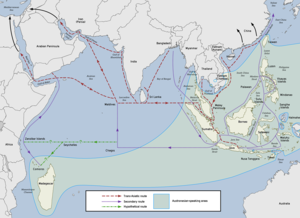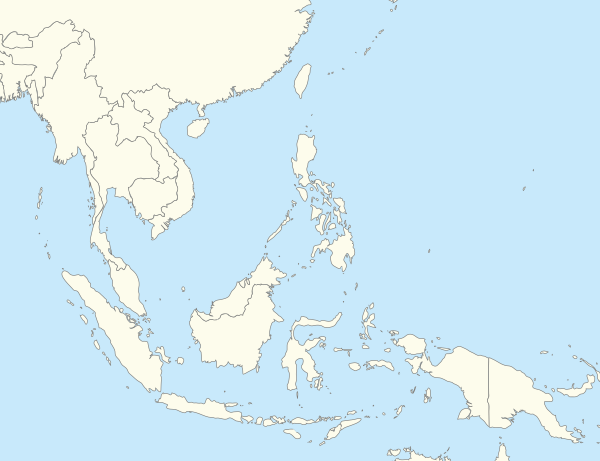Maritime Southeast Asia
Maritime Southeast Asia comprises the countries of Brunei, Indonesia, Malaysia, the Philippines, Singapore, and East Timor.
| Geography | |
|---|---|
| Location | Indonesian Archipelago Philippine Archipelago Peninsular Malaysia East Malaysia Singapore |
| Total islands | 25,000 |
| Major islands | Borneo, Java, Luzon, Mindanao, Sulawesi, Sumatra |
| Area | 2,870,000 km2 (1,110,000 sq mi) |
| Highest elevation | 4,095 m (13435 ft) |
| Highest point | Mount Kinabalu |
| Largest settlement | Bandar Seri Begawan |
| Largest settlement | Jakarta |
| Largest settlement | Kuala Lumpur |
| Largest settlement | Quezon City |
| Largest settlement | Singapore |
| Largest settlement | Dili |
| Demographics | |
| Population | 380,000,000 |
| Ethnic groups | Predominantly Austronesians, with minorities of Negritoes, Papuans, Melanesians, descendants of Chinese (including Peranakans), Arab descendants, Eurasians, Mestizos, Orang Asli and descendants of Overseas Indians and Sri Lankans |

The term Island Southeast Asia or Insular Southeast Asia is sometimes given the same meaning as Maritime Southeast Asia. Other definitions restrict Island Southeast Asia to just the islands between mainland Southeast Asia and the continental shelf of Australia and New Guinea. There is some variability as to whether Taiwan is included in this. Peter Bellwood includes Taiwan in his definition, as does Robert Blust, whilst there are examples that do not.
The 16th-century term "East Indies" and the later 19th-century term "Malay Archipelago" are also used to refer to Maritime Southeast Asia.
In Indonesia, the Old Javanese term "Nusantara" is also used as a synonym for Maritime Southeast Asia. The term, however, is nationalistic and has shifting boundaries. It usually only encompasses Peninsular Malaysia, the Sunda Islands, Maluku, and often Western New Guinea and excludes the Philippines.
Stretching for several thousand kilometres, the area features a very large number of islands and boasts some of the richest marine, flora and fauna biodiversity on Earth.
The main demographic difference that sets Maritime Southeast Asia apart from modern Mainland Southeast Asia is that its population predominantly belongs to Austronesian groups. The region contains some of the world's most highly urbanized areas—the Greater Manila Area, Greater Jakarta, Singapore, and Greater Kuala Lumpur—and yet a majority of islands in this vast region remain uninhabited by humans.
Geography
This section needs additional citations for verification. (February 2022) |
The land and sea area of Maritime Southeast Asia exceeds 2 million km2. These are more than 25,000 islands of the area that comprise many smaller archipelagoes.
The major groupings are:
The seven largest islands are Borneo, Sumatra, Sulawesi and Java in Indonesia; and Luzon and Mindanao in the Philippines.
In the natural sciences, the region is sometimes known as the Maritime Continent. It also corresponds to the biogeographical region of Malesia (not to be confused with "Malaysia"), with shared tropical flora and fauna.
Geologically, the archipelago is one of the most active volcanic regions in the world, producing many volcanoes, especially in Java, Sumatra, and the Lesser Sunda Islands region, where most volcanoes over 3,000 m (9,800 ft) are situated. Tectonic uplifts also produced large mountains, including the highest in Mount Kinabalu in Sabah, Malaysia, with a height of 4,095.2 m (13,436 ft) and Puncak Jaya on Papua, Indonesia at 4,884 m (16,024 ft). Other high mountains in the archipelago include Puncak Mandala, Indonesia at 4,760 m (15,620 ft) and Puncak Trikora, Indonesia, at 4,750 m (15,580 ft).
The climate throughout the archipelago is tropical, owing to its position on the Equator.
Biogeography

Island Southeast Asia is crossed by the Wallace Line. This line divides the flora and fauna of Asia from that of Australia and New Guinea with stretches of water that have always been too wide for plant and animal species to cross readily. The gaps are considered to be large enough to make accidental rafting from one side to another to be unlikely events. Apart from birds, species that have managed to cross this line include those that have been moved by humans. There is a transitional zone adjacent to the Wallace Line that is termed Wallacea. This is a zone where examples of animal and plant species from both sides can be found, but, particularly on smaller islands, there may be a greatly reduced number of terrestrial species.: 1–15
The biographical division of the region is important for understanding the spread of both modern and archaic humans into the region. The Wallace Line represents a sea barrier that has persisted, as far as is known, even at the lowest sea levels of glacial maxima of the Pleistocene and the Holocene. Therefore we know when watercraft of some (admittedly unknown) description must have been used by humans to cross the sea.: 15
Culture and demographics
As of 2017, there were over 540 million people living in the region, with the most populated island being Java. The people living there are predominantly from Austronesian subgroupings and correspondingly speak western Malayo-Polynesian languages. This region of Southeast Asia shares social and cultural ties with both the peoples of mainland Southeast Asia and with other Austronesian peoples in the Pacific. Islam is the predominant religion, with Christianity being the dominant religion in the Philippines and East Timor. Buddhism, Hinduism, and traditional Animism are also practiced among large populations.[citation needed]
Historically, the region has been referred to as part of Greater India, as seen in Coedes' Indianized States of Southeast Asia, which refers to it as "Island Southeast Asia"; and within Austronesia or Oceania, due to shared ethnolinguistic and historical origins of the latter groups (Micronesian and Polynesian groups) being from this region.
History

The maritime connectivity within the region has been linked to it becoming a distinct cultural and economic area, when compared to the 'mainland' societies in the rest of Southeast Asia. This region stretches from the Yangtze delta in China down to the Malay Peninsula, including the South China Sea, Gulf of Thailand and Java Sea. The region was dominated by the thalassocratic cultures of the Austronesian peoples.
Ancient Indian Ocean trade

The first true maritime trade network in the Indian Ocean was by the Austronesian peoples of Island Southeast Asia.[failed verification] They established trade routes with Southern India and Sri Lanka as early as 1500 BC, ushering an exchange of material culture (like catamarans, outrigger boats, lashed-lug and sewn-plank boats, and paan) and cultigens (like coconuts, sandalwood, and sugarcane); as well as connecting the material cultures of India and China. Indonesians, in particular were trading in spices (mainly cinnamon and cassia) with East Africa using catamaran and outrigger boats and sailing with the help of the Westerlies in the Indian Ocean. This trade network expanded to reach as far as Africa and the Arabian Peninsula, resulting in the Austronesian colonization of Madagascar by the first half of the first millennium AD. It continued up to historic times.
Maritime Silk Road
The ancient Austronesian trade networks was later used by the first Chinese trading fleets of the Song Dynasty at around 900 AD. It led to a renewed flourishing of trade between China and Southeast Asia, now known as the Maritime Silk Road. Demand for Southeast Asian products and trade was partially driven by the increase in China's population in this era, whereby it doubled from 75 to 150 million.
Trade with China ceased after the collapse of the Song Dynasty due to invasions and famine. It was restored during the Ming Dynasty from the 14th to 16th centuries. The naval expeditions of Zheng He between 1405 and 1431 also played a critical role in opening up of China to increased trade with Southeast Asian polities.
Chinese trade was strictly controlled by the Imperial Court, but the Hokkien diaspora facilitated informal trade and cultural exchange with Southeast Asia, settling among Southeast Asian polities during this time period. Despite not having the official sanction of the Chinese government these communities formed business and trade networks between cities such as Melaka, Hội An and Ayutthaya. Many of these Chinese businesspeople integrated into their new countries, becoming political officials and diplomats.
See also
- Southeast Asia
- Brunei Darussalam–Indonesia–Malaysia–Philippines East ASEAN Growth Area
- Philippine archipelago
- Indonesian archipelago
- Farther India
- Greater India
- Greater Indonesia
- Maritime Continent
- Malay race
- Malay world
- Malesia
- Nanyang
- Peninsular Malaysia
- Domesticated plants and animals of Austronesia
Notes
References
External links
- Art of Island Southeast Asia, a full text exhibition catalog from The Metropolitan Museum of Art
This article uses material from the Wikipedia English article Maritime Southeast Asia, which is released under the Creative Commons Attribution-ShareAlike 3.0 license ("CC BY-SA 3.0"); additional terms may apply (view authors). Content is available under CC BY-SA 4.0 unless otherwise noted. Images, videos and audio are available under their respective licenses.
®Wikipedia is a registered trademark of the Wiki Foundation, Inc. Wiki English (DUHOCTRUNGQUOC.VN) is an independent company and has no affiliation with Wiki Foundation.
















